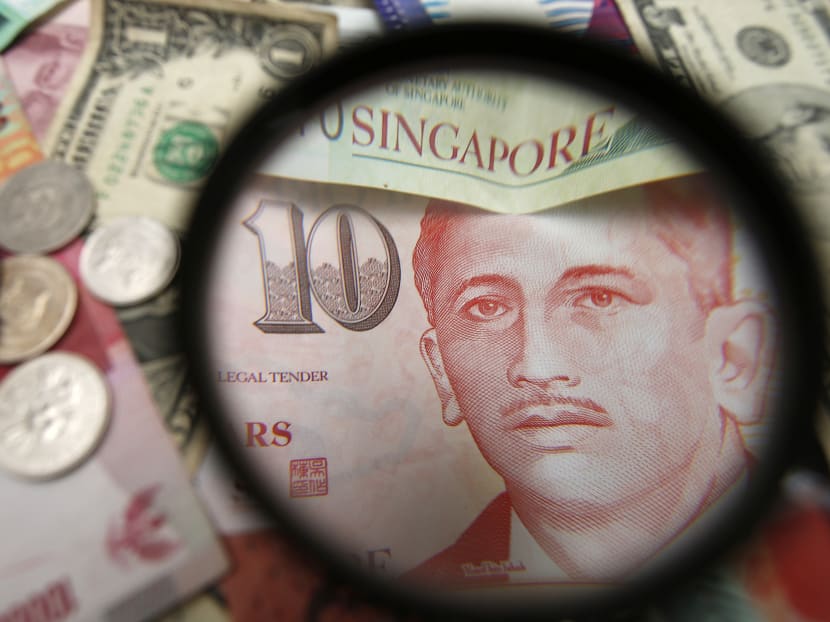Explainer: What reduction of Singdollar appreciation rate means
SINGAPORE — The Monetary Authority of Singapore (MAS) will be reducing the rate of appreciation of the Singapore Dollar Nominal Effective Exchange Rate (S$NEER) policy band, as the economy grinds against a broader global economic slowdown and trade tensions between the United States and China.

Analysts said that the slow rate of economic growth and low inflationary pressure are the main motivations behind the central bank's policy move to reduce the Singdollar's appreciation rate.
SINGAPORE — The Monetary Authority of Singapore (MAS) will be reducing the rate of appreciation of the Singapore Dollar Nominal Effective Exchange Rate (S$NEER) policy band, as the economy grinds against a broader global economic slowdown and trade tensions between the United States and China.
On Monday (Oct 14), the central bank announced that it would "reduce slightly" the Singdollar policy band's appreciation rate, from the "modest and gradual appreciation" path before.
There would be no change to the width of the policy band and the level at which it is centred, which is consistent with stabilising prices in the medium term, it added.
The last time MAS reduced the policy band was in April 2016, during a period of dampened growth and inflation outlook.
TODAY takes a look at what the economic jargon means and why it is of concern.
WHAT IS S$NEER?
S$NEER is the exchange rate between the Singapore dollar and a basket of currencies in the country’s major trading partners.
The central banks in other countries use interest rates as a monetary policy but MAS uses the currency exchange rate to ensure the prices of goods and services remain stable.
It acts as a stronger influence on inflation than interest rates.
This is because Singapore has a small and open economy, where gross exports and imports of goods and services make up the bulk of its gross domestic product (GDP).
S$NEER thus affects a wide range of prices in Singapore’s economy, such as the import and export prices, wages and rentals, consumer prices and output prices.
In its latest monetary review, MAS said that while it expects Singapore’s GDP to pick up modestly next year, “the level of output will remain below potential”.
HOW DOES IT WORK?
MAS does a monetary policy review twice a year in April and October by setting a path for the S$NEER policy band, to ensure price stability in the medium term.
The strength of the Singapore dollar is managed against the basket of currencies, along the policy band.
The Singdollar can appreciate and depreciate against this basket of currencies, provided that it remains within this band.
This is done by allowing the band to appreciate at different rates, according to the current and future forecasted price developments in the economy.
So there may be shifts in the slope of the S$NEER policy band and occasionally, changes to the width of the band.
If the band’s slope is sharpened, or steered upwards at a steeper angle, it will allow the dollar to appreciate faster.
This is done when inflation is high. With a stronger Singdollar, imports become relatively cheaper, and will prevent a sudden spike in the prices of goods and services.
When inflation is low or negative, the MAS might reduce the slope of the band, which will make the Singdollar appreciate at a slower pace.
WHY REDUCE THE APPRECIATION RATE?
MAS expects global economic growth to slow discernibly this year compared with the previous two years, with a view that things would stabilise in 2020 barring further shocks.
As it is, growth has slowed “more significantly” in the second quarter, taking a heavier toll on manufacturing and trade.
“There are (early) signs that the downturn could spill over into domestic demand in some of Singapore’s major trading partners in the quarters ahead, even as macroeconomic policy conditions in these economies have turned more accommodative,” MAS said.
Analysts told TODAY that the slow rate of economic growth and low inflationary pressure are the main motivations behind the MAS’ policy move.
Mr Bernard Aw, principal economist at research firm IHS Markit, said: “MAS mentioned in its policy statement that the output gap has turned slightly negative, which means that economic activity (or GDP) fell slightly below the economy’s potential.
“This is usually a precursor to falling costs or a slower growth in costs, suggesting that price inflation is likely to slow down. So the policy move is appropriate.”
Ms Selena Ling, head of strategy and research at OCBC bank, said that the recent first phase of the US-China trade deal may lift near-term market sentiments, but it is still dependent on the outcome of negotiations at the second and third phase.
“The fourth-quarter growth prognosis still remains soft. We anticipate another anaemic fourth-quarter GDP growth, with the risk that full-year GDP growth may come in on the lower end of the official 0 to 1 per cent year-on-year forecast,” she said.
WHAT DOES THIS MEAN?
When the appreciation rate is eased, it makes imports more expensive in Singdollar terms while boosting exports or demand for goods and services made here.
However, analysts said that this would not necessarily make exports cheaper.
Mr Aw said: “Despite the reduction in slope, the MAS is still maintaining an appreciation in the S$NEER, albeit slower… Furthermore, the S$NEER has fluctuated within the upper half of the policy band over the last six months, suggesting that demand for the Singdollar has been solid.”
Echoing his sentiments, Ms Ling said: “The impact of a weaker S$NEER may not immediately translate into cheaper Singapore exports and, in turn, an export rebound. This is because the overall external economic environment due to the uncertainties from the trade and tech war remains.”
HOW WILL IT AFFECT SINGAPOREANS?
For the average Singaporean, the latest move has little impact, the analysts said.
“For the man-on-the-street, the impact is likely to be relatively muted because many other central banks are also easing monetary policy and the MAS move was already discounted to a large extent,” Ms Ling explained.
Mr Aw said that the global trade conditions are more worrying: “What we should be concerned with is whether global trade conditions are going to worsen in the coming months as this will have a greater impact on Singapore’s economy, which in turn will affect business activity and jobs.
“Should the global economy worsen sharply, pressure on the government to provide more policy support, including fiscal measures, will intensify.”








